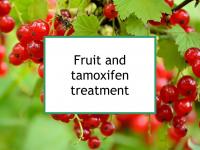The current webpage is designed to make additional research available concerning how certain fruits or their major bioactive components can enhance tamoxifen treatment. At the bottom of this webpage are links to studies relating to the beneficial fruits listed in Foods to eat & avoid during tamoxifen treatment.
Pomegranates, their juice and extracts, have been tested and found specifically to increase tamoxifen's treatment effects.
Generally speaking, fruits enhance the treatment effects of tamoxifen or counteract its side effects primarily through the actions of certain polyphenols, among them:
- Beta-carotene (found, for example, in apricots, cantaloupe, and mangoes)
- Ellagic acid (blackberries, boysenberries, muscadine grapes, strawberries)
- Lycopene (watermelon)
- Phloretin (apples)
- Pterostilbene (blueberries & bilberries, grapes - especially black or red)
- Quercetin (black currants, cranberries & lingonberries, raspberries)
- Resveratrol (blueberries & bilberries, red grapes, red currants)
- Ursolic acid ( apples , cherries - especially sour or tart, cranberries & lingonberries)
as well as the hormone melatonin (cherries, especially sour or tart).
Please read the applicable food webpages when making your own food lists since these pages contain important advice, food rankings (e.g., highly recommended, recommended in moderation), consumption limits, and other pertinent information.
Fruit compounds should be obtained by eating fruit rather than taking supplements. When a beneficial micronutrient is administered at low doses by consuming food, it is likely to have subtle chemopreventive effects, whereas the same compound administered at high doses is more likely to have pharmacological effects, with possible unwanted outcomes. For example, resveratrol has been reported to promote proliferation of ER+/PR+ cells under some circumstances. In fact, while resveratrol has been shown to reduce ER+ cell growth at the earlier stages of cancer development, it can promote ER+ proliferation during later stages.
